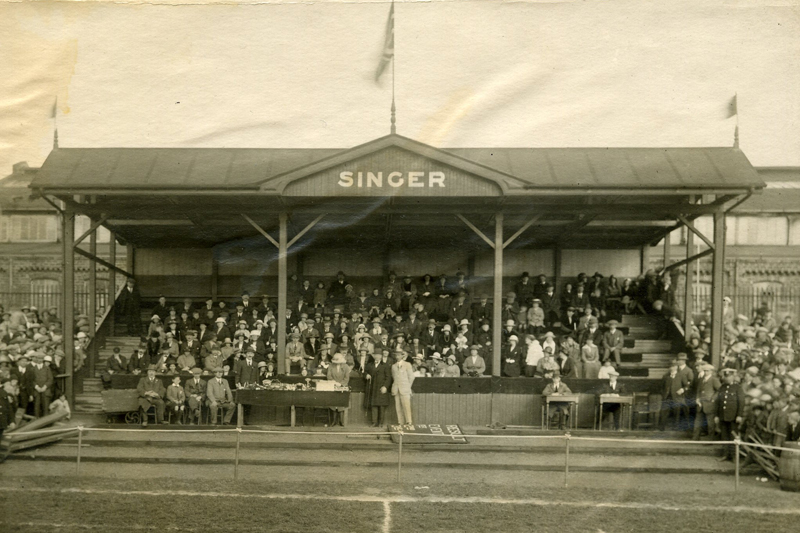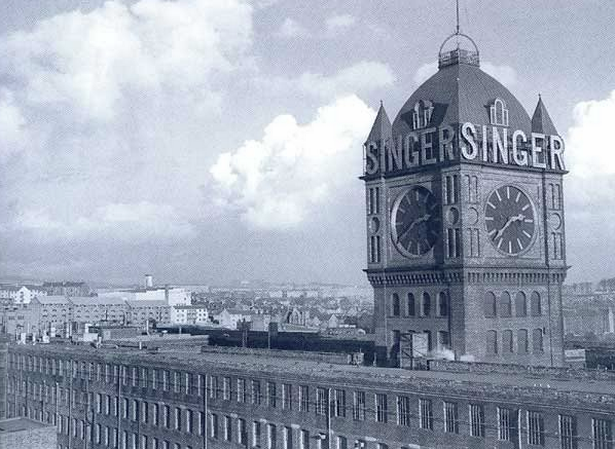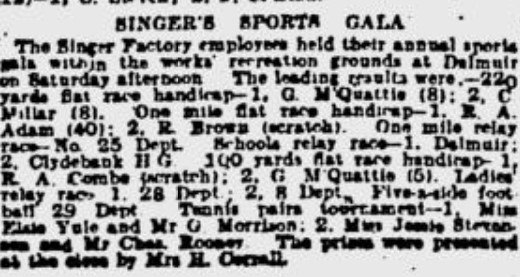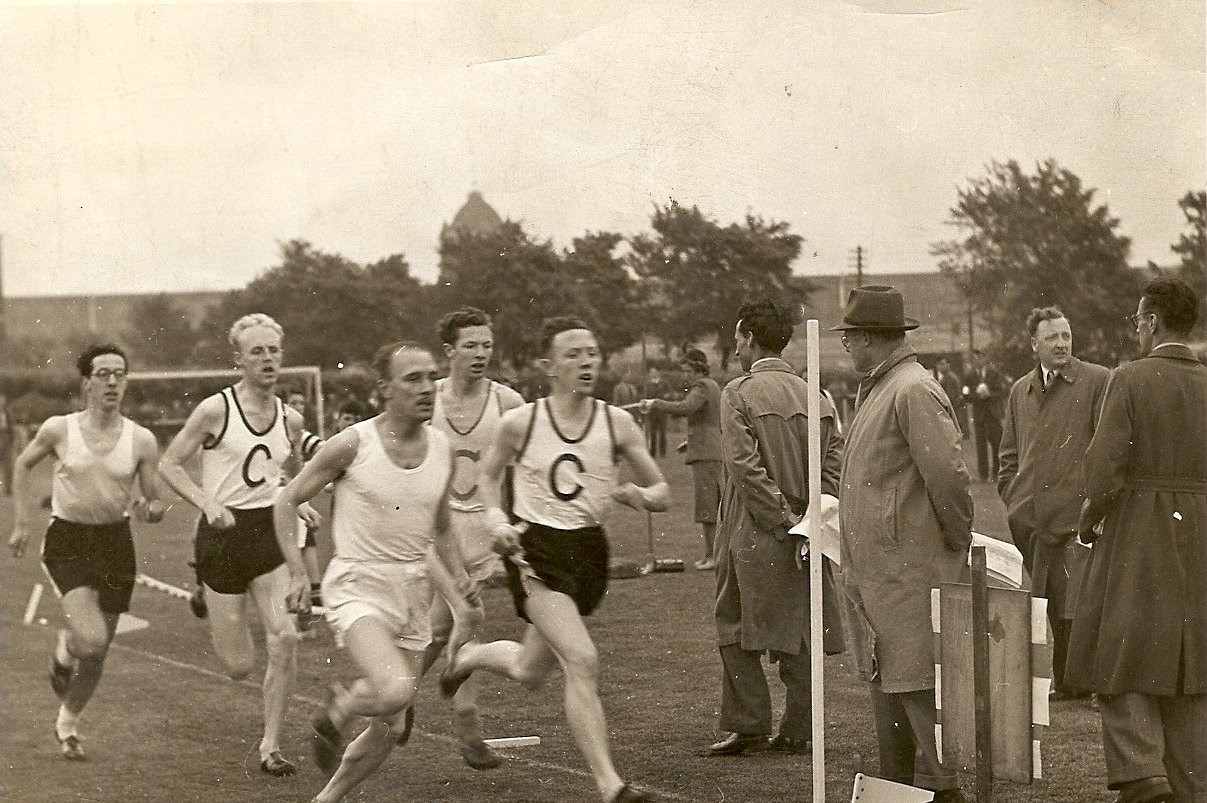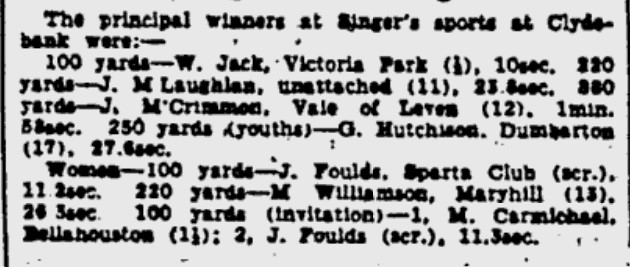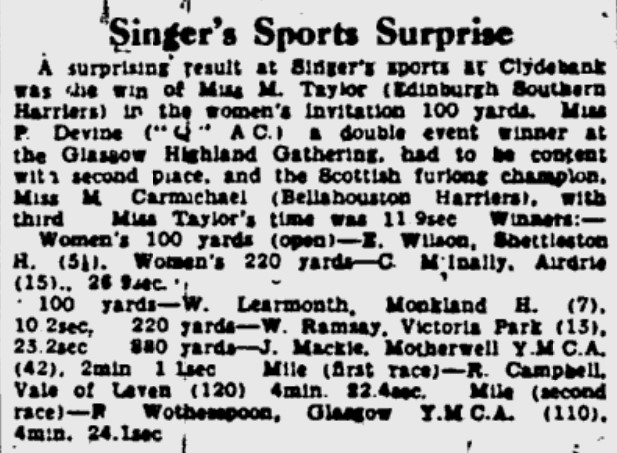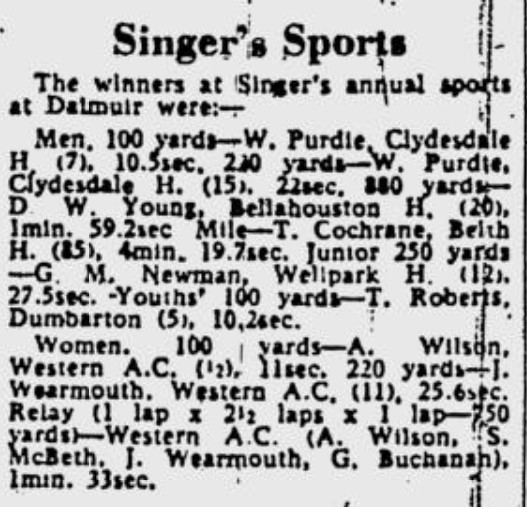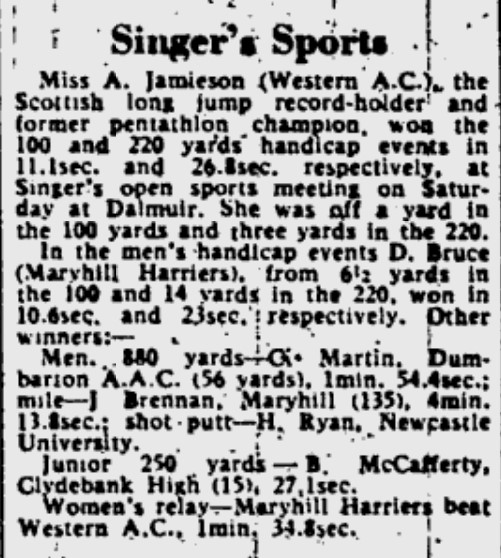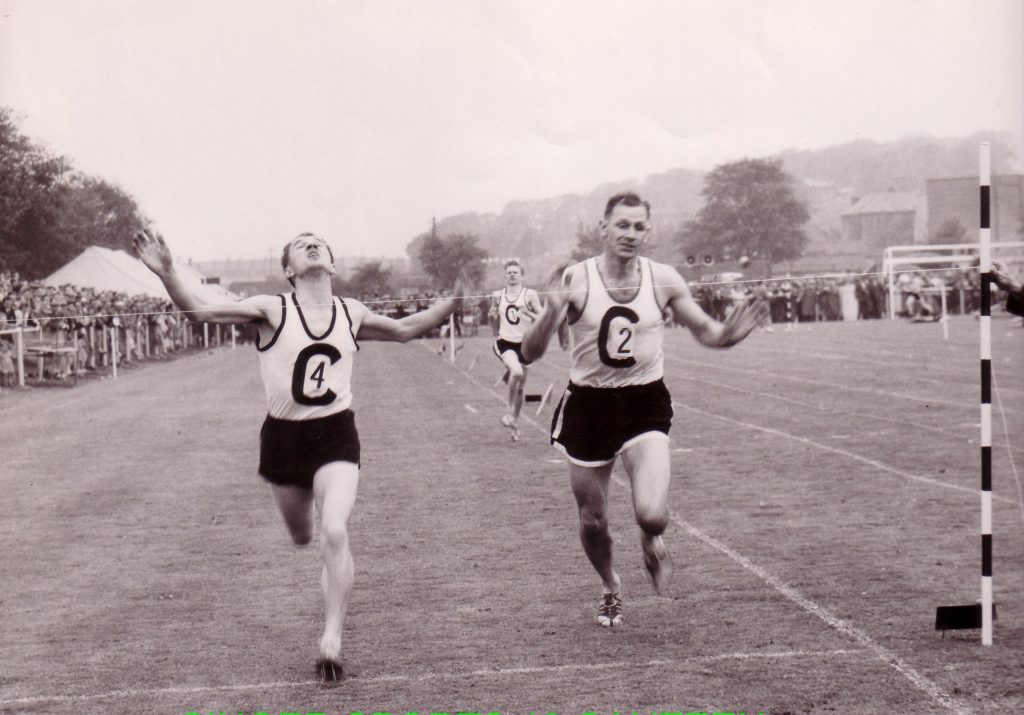The stand at Singer’s Recreation Ground, Clydebank
The Singers Sports was a regular fixture on the SAAA Calendar after the Second World War and was held on the first Saturday in June with some of the very best athletes in the country competing there. Its history goes back well before the war however and the picture of the stand above, situated on the north side of the track, dates from the 1930’s. Many factories and manufacturing firms had their own sports sections and, even as recently as the 1960’s, Babcock & Wilcox (Renfrew), Dirrans (Kilwinning) and Singers had their own sports. Singer was a massive factory: read the following from ‘Glasgow Live’.
“The factory came into being thanks to Scots born George Ross McKenzie, who, while serving as General Manager of The Singer Sewing Machine Company, the first successful American multi-national company in the world. … Benefited from a location both next to a railway line and the Forth and Clyde canal, then Vice President McKenzie breaking ground on it in 1882 in a construction that lasted three years and required 20 million bricks before it opened in 1885. Originally featuring two main buildings 800ft long and 50ft wide and 3 storeys high connected by three wings, it was designed to be fire proof with water sprinklers making it the most modern factory in Europe at that time. And barely a decade later, the Kilbowie factory would become Singer’s flagship factory, with a workforce of over 5000 strong manufacturing 80% of the world’s sewing machines. So big was the factory that it had its own train station (still present today), with production levels so high that two-and-a-half miles of railway track were laid to link up assembly lines, foundries, tools hops, storage and distribution centres. And so productive was the factory that in 1905 the US Singer Company set up the Singer Manufacturing Company Ltd. as a UK registered company, with demand so high that each building in the factory (then the world’s largest) was extended upwards to 6 storeys high.
With 11,500 workers employed at the plant at its peak, in 1913 Singer shipped 1,301,851 sewing machines from its factory doors to households and businesses around the world.”
The Singer clock was the world’s largest four faced clock, five feet bigger than Big Ben
was a massive operation and encouraged its employees to take part in all kinds of sports – there was a football team, a cricket team, a bowls club, an athletics club and it also catered for indoor sports. The bowlers had their own green and clubhouse and the others took place at the recreation ground. Among the thousands of employees, were many members of Clydesdale Harriers, based in the town, many of whom were in promoted positions. Therefore when the idea of an annual sports and gala day came up, they helped with the organisation.
Clydebank and its environs always a sport loving community and there had been several athletics meetings held over the years. In 1919 there had been a good one held at Old Kilpatrick with many athletes from Clydesdale Harriers as well as repr3sentatives of all the Glasgow clubs. The first Singers Sports reported in the Glasgow Herald on 6th June 1921. The report in its entirety is below.
The reference right at the start to ‘their annual sports’ seems to indicate that there had been similar sports previously but there is no indication for how long. They also seem to have been exclusively for employees and local schools. Note that the High School w as HG which was Higher Grade (or Senior Secondary) as opposed to Dalmuir School which was not Higher Grade. George McQuattie was a member of Clydesdale Harriers but the club affiliation was not given. The Sports were always on the same weekend – the first in June. This meant a clash with Queen’s Park FC Sports and the Scottish Universities Championships as well as several of the major schools events. But, given that it was at this point a ‘closed’ meeting with a restricted range of events, this would not have been a factor in their calculations.
The following year, on 3rd June 1922, the events were largely the same with a Ladies Race as well as a ladies relay – women’s athletics were just starting to appear in the country and this was an interesting venture. There were also boys races and relay. There was also a tennis tournament and a five a side football competition. This was the pattern for the 20’s – confined races, races for local schools as well as tennis and the almost mandatory 5-a-sides. The origins of the Sports – or Sports Gala as it was sometimes referred to – were not reported on at the time but the report on the 1927 meeting started by saying: “In showery weather, the twelfth annual sports gala in connection with the Singer works was held at the Recreation Ground, Dalmuir on Saturday.” So 1915 was the first year. Names that appeared in the results included A Gailey (later a member and treasurer of Clydesdale Harriers before he emigrated), G McQuattie and in the women’s 75 yards race the winner was Peggy Ellison who was a prominent member of the Clydesdale Harriers Ladies when it started up in 1930.
They were always trying new ways to entertain the crowd and in 1929, there was a children’s pageant with historical tableaux, songs and dancing, there were also gymnastics exhibitions by members of the YMCA. The pageant would develop to the crowning of the Singer Queen with her retinue of the 1950’s. There were also the usual athletics events and the piping was also a feature although the tennis and 5-a-side seemed to have disappeared by then.
The first sports of the new decade was on 9th June 1930 and the pageant led to the crowning of the Queen of the Fair (Margaret Pattison). One of the other innovations during the thirties was the introduction of a relay for the school girls as well as the existing one for boys. This was however the format until the war started in 1939.
During the War, the factory was devoted to making equipment and supplies for the war effort and there was no time or room in the year for such niceties as the Sports Gala. During this period the factory received over 5000 government contracts, made 303 million artillery shells, shell components, shell fuses, aeroplane parts as well as grenades, rifle parts and 361,000 horseshoes. The company labour force of 14,000 at the end of the war was 70% women.
After the war the sports started up with a difference or two. The ‘Glasgow Herald’ report read as follows: “Singer Recreation Club’s Sports were distinguished by the performance of Any Forbes (Victoria Park) who won one of the Mile handicaps from the small allowance of five yards to win in 4 min 24.6 sec over a course of six laps to the mile and against a strong wind. Other winners: 100 yards W McDonald (Clydesdale Harriers) (8 1/2) 10.9 sec; 220 yards: J O’Kane (Garscube) (14) 23 sec; 880 yards: W McCrimmon (Vale of Leven) (44) 2 min 1 sec; Mile B: J Stirling (Victoria Park) (105) 4 min 34.9 sec.” There were several points to take from that report, brief as it is. First is the fact that there are no results of the confined events although there were still many to be seen on the day. Second, there was a full programme of open events which were well supported and which, in the eyes of the reporter, took precedence over the confined races.
Not mentioned: 1. The pageant was still a feature of the sports and would be there until the sports came to an end in the late 60’s. 2. The tennis had gone altogether from the Gala and 3. the football was held away from the meeting too. It had in fact become a genuine open sports meeting albeit on a short grass track. The Recreation Ground was also used by other community groups – the photograph below is of the invitation half mile race in the mid 1950’s at the Clydebank High School Sports which were held there.
Photograph by Jim Young, leading above
A year later and again, it was a short report but the papers were only 6 or 8 pages long, there was a full spoprts programme and a local meeting was maybe fortunate to have the results printed at all. This time the man mentioned first was George McDonald of Victoria Park who was second in both open and confined 100 yards races. The winners of the sprints were J Wilson of Clydesdale in the 100 yards from a mark of 7 yards in 10.1 sec and the 220 by DT Clark of Garscube, also off 7 yards in 23.2 seconds. Jim Young of Clydesdale won the 880 in 1:58.6 from 45 yards and Ben Bickerton of Shettleston took the Mile from a mark of 40 yards in 4 min 38.5. The Junior one lap race was won by R Whitelock of Victoria Park in 36.9 from 17 yards and the Women’s 100 yards was won by I Irving (Clydesdale ) 11.3 sec from a mark of 8 yards.
The sports were becoming a bit better known and the calibre of athlete was getting higher. This was helped by the Guest of Honour in 1951. Like many other local sports meetings and highland gatherings, Singer Sports and Gala Day had a guest of honour – the best known of there was Dorothy Lamour who came along a few years after this but in 1951 it was Olympic sprinter June Foulds from London. She had come to prominence as a 16 year old and would go on to run in the 1952 and 1956 Olympics. After opening the Sports she took part in both 100 yards races (open and invitation) with the results seen below. Scots M Carmichael and Willie Jack were also international athletes.
Things just continued to progress. The meeting in 1952 provided a big shock in the women’s events where two British International athletes came face to face. One was Pat Devine of the Q Club in Dundee who would be the first Scottish woman to compete in the Empire Games, the European Games and the Olympic Games. She and her clubmate Elspeth Hay were the first Scottish women ever to be selected for a GB team. Of course, the handicaps had something to do with the final results but the winners in both 100 and 220 yards were off quite short handicaps. Wotherspoon of the YMCA would go on to become a good, medal winning, member of Shettleston Harriers.
The competition between meeting organisers on the first Saturday in June was fierce, coming as the date did a mere three weeks before the national championships and with the short track and grass surface, Singers Sports were at a disadvantage. In 1954 for instance, they were competing against the big budget and 440 yards track at Shawfield where the Lanarkshire Police were holding their sports, The Scottish Universities were big players in the sport in the early 50’s and they had their national championships on the same date, and on this date in 1954 the new cinder track at Caird Park was having its grand opening meeting with home girls Pat Devine and Elspeth Hay taking part and Joe McGhee of Shettleston Harriers taking on local hero Chick Robertson over 13 miles on the road. There were many schools championships being held too The draw at Singers however was star long distance runner Ian Binnie who was taking his chances over the half mile distance as a test of how his speed work was coming along in the run-in to the SAAA event. As it turned out, he won his heat but could only come fourth in the final behind W Gall of Maryhill Harriers off 68 yards in 1:58.6 seconds. Binnie had won his heat in 2:00.4. The meeting went as well as usual but Binnie was the only star name that yea. There is a clip of the meeting which is more of a general interest programme with the emohasois on the pageant and the Gala Queen than on the athletics at
Watch Singer Sports and Gala 1954 online – BFI Player
The 50’s were good for Singers Sports Gala the 60’s were better. The programme grew – in 1960 there were the events that we know of already – open races, schools races and confined races ,but there were also more field events, more women’s events (there were open relays as well as confined for instance) and Inter-Works competitions against such as John Brown’s shipyard. And there was the pageant which was something that none of the other meetings of the summer could equal – if a sewing machine factory could not produce elegant dresses, who could?
In 1961 Ronnie Whitelock won his heat of the 100 yards off half a yard and was beaten by that much in the final by Gibbons of Vale of Leven who was running from 6 yards. Whitelock’s time was 9,8 seconds. The works relay which was won by Babcock & Wilcox was run over stages of 3 laps, 1 lap, 1 lap and 2 laps on a track that was 6 laps to the mile. The women’s events were dominated by the Ardeer Recreation AC who won the 100 yards and the relay while Moira Carmichael took the 220 yards.
The 1963 event is summarised in the results above – top quality athletes all through the programme. Tom Cochrane from Beith was a superb runner who won the South Western District Cross Country championship 7 times and was a Scottish international runner, Bill Purdie who competed in open races, scratch races and invitation events all summer, every summer and the women who took the prizes above were all international or international class. Note particularly Anne Wilson, Sheila McBeth and Georgena Buchanan. 1964 was even better, see below
And Colin Martin and Jim Brennan were not even mentioned in the report.
John Maclachlan (4) just beats Pat Younger (2) in the confined half mile.
The 1965 meeting was certainly the one with the biggest celebrity roll call of them all -Ian McCafferty, Graeme Grant, Cyril O’Boyle, Ian Logie, Avril Beattie, Jinty Jameson, Linda Carruthers were all winners and there were other down the field in many of the events. Have a look at the report. 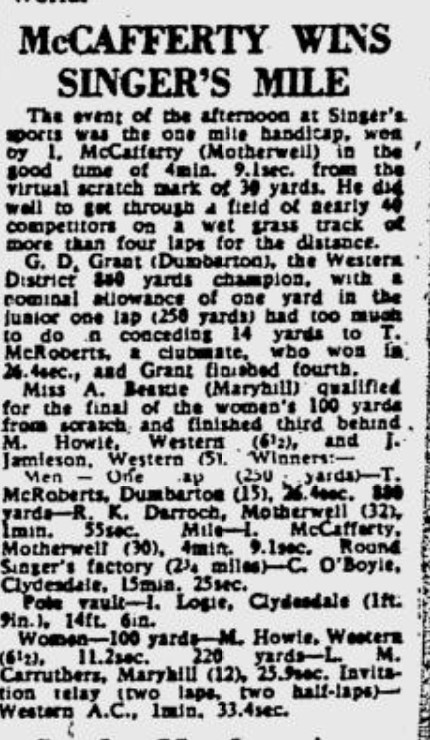
Nearly 40 runners in the Mile on a 6 lap to the mile grass track! This had previously been the longest race on the programme but by now there was a ‘Round the Factory’ race which was won by Cyril O’Boyle. The pole vault was relatively new to the sports and was won by Ian Logie who was an SAAA Internationalist and championship medallist. The entire Western Ladies team was almost certainly all international in make up. Unfortunately it was probably the last ever. It is the last one that we have found reports on.
Any other sports organising committee having the success of this meeting would have been happy to keep it going – the sport was good and the crowds were coming every year. It was a successful community event. The factory was starting to have a hard time however – read about it on google and many cuts were being made all the way through the factory and it closed finally in 1980. It was a pity that a factory which, true to the spirit of the time was interested in and catered for the welfare of its workers and the community in which it found itself. The Burgh still has the Singer Bowling Green and the Singer Hall, donated by the firm, however to thank the company for in addition to all its great memories.
..
